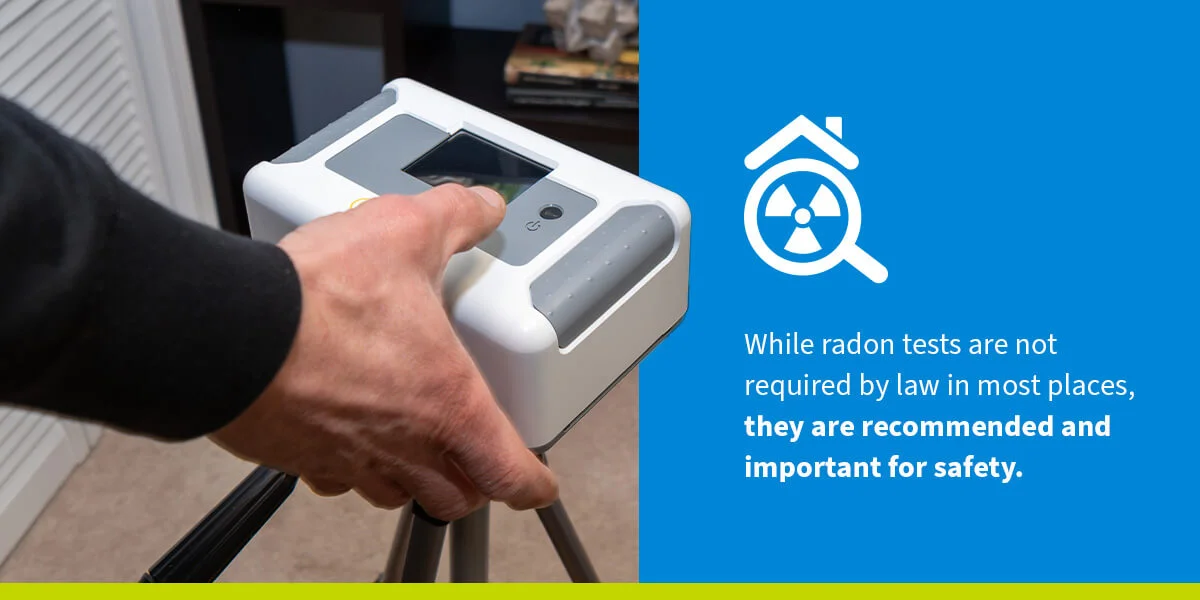You can’t see it, you can’t smell it, you can’t taste it…but nearly one out of every 15 homes in the United States has it.
We’re talking about radon, a colorless, odorless, silent gas found in homes across the county — and this radioactive gas has adverse effects on human health.
The Environmental Protection Agency (EPA) states that radon is responsible for over 21,000 lung cancer deaths each year. In fact, it is the number one cause of lung cancer among nonsmokers.
There’s one way to know if your home has radon — you have to test for it. So, what if your home has radon when you’re looking to sell? Read on to learn if radon testing is required to sell a home and your options for selling a home with radon.
Why Do So Many Houses Have Radon?
First, the basics. Where does radon come from? This invisible gas is produced when naturally occurring elements — like radium, thorium, and uranium — decay.
Since these elements are commonly found in dirt and rocks, they’re under and around our homes.
While radon can dissolve into water, it usually disperses through the air. A heavy gas, radon sneaks into buildings through cracks and gaps in walls and floors, around pipes and wires, and anywhere there’s an opening. Then, it pools in lowered spots, such as basements and crawl spaces.
High radon levels have been discovered in homes across the country, as the EPA’s Radon Zone Map illustrates. Radon can be found anywhere, in any structure, from historic homes to new construction.
Does Your House Need a Radon Test?
Radon breaks down into tiny radioactive particles in the air. When people breathe these particles in, they lodge in the lungs and damage cells. According to the American Cancer Society, exposure to high radon levels has been linked to increased risk and rates of cancer. The risk grows with higher radon levels and greater exposure. That’s why you want to test your home to determine the levels of radon gas.
You can’t see, smell, or hear radon, so testing is the only way to know if it’s present in your home. Because radon is so common and poses a health risk, all homes should be tested.

While radon tests are not required by law in most places, they are recommended and important for safety. Additionally, if you have conducted a radon test, most states require you to report the results to a buyer before selling your home. If you’re not selling your home, the EPA still suggests testing at least every two years.
If the radon test results show levels higher than 4 pCi/L (that’s picocuries per liter of air), that’s a problem. Even radon levels below 4 pCi/L can pose a risk and be reduced.
How Does Radon Testing Work?
Now that you know why you need one, the next step is understanding how radon tests work.
The Radon Testing Process
A radon test is placed in the lowest lived-in level of your home, about 20 inches off the floor, and left there for a certain period. As levels can fluctuate, it’s important to measure levels over time. A long-term test measures radon levels over a 90-day period, or you may do two short-term tests that take a few days.
During this time, the test measures levels of radon or its byproducts in your home. After the testing time has passed, you need to check the information the test has recorded. Depending on the type of test you use, you may need to send it to a laboratory to get your results.
Types of Radon Tests
There are several types of radon tests, but they fall into two main categories:
- Passive tests: These do not require a power source to work. They include alpha‑track detectors, charcoal canisters, charcoal liquid scintillation devices, and electret ion chamber detectors. Passive tests are usually easily accessible at hardware and drug stores or online, and they’re inexpensive. There are short-term (two-90 days) and long-term (over 90 days) passive tests, and you will need to send your test to a laboratory to receive the report after the testing time.
- Active tests: These require power to run. They include continuous radon monitors and continuous working level monitors. These devices cost more but generate more reliable and detailed results, which a professional tester can explain to you.
DIY vs. Professional Testing
You can do the tests yourself or hire a professional. Check with your state radon office to ensure your choice meets the legal requirements for your state.
DIY testing can be more affordable and convenient. However, you may need to meet professional testing standards to sell a home in your state. Professional tests also offer the following advantages:
- Accuracy: With a professional test, you and your buyer can trust the accuracy of the result. This resolves anxieties and avoids disputes down the line.
- Detail: If radon is present, a professional report can give you more thorough information about radon levels, potential sources and causes, and mitigation strategies and costs. This information can help you address the situation.
Radon Testing Cost
Radon testing costs vary, but home kits typically cost around $150, while professional radon testing services cost around $700 on average. Though they’re more expensive, professional active tests provide more reliable results.
Do You Need Radon Mitigation Services?
If radon test results indicate 4 pCi/L or more, you’ll need to invest in radon mitigation services to solve the problem. A radon mitigation system can reduce levels to a safer range.
Reliable radon mitigation requires the intervention of a radon mitigation contractor. Many states require certification for radon mitigation contractors to operate.
A radon mitigation contractor can:
- Check the test and do additional measurements if necessary.
- Create and communicate the right radon mitigation strategy for your home.
- Design and install a system that meets federal and state regulations.
- Follow up to ensure that radon is reduced to safe levels.
Radon mitigation can be expensive, but it’s essential for the health and safety of those living in or moving into a home.
Is Radon Testing Required to Sell a Home?
What happens if you want to sell your home? High radon levels can be a deal-breaker for a buyer. It presents a safety issue, and many buyers won’t want to deal with the costs and hassle of radon mitigation.
Many states require home sellers to disclose the results of radon tests to potential buyers. Further, the EPA recommends testing all homes during the home inspection process.
For many buyers, the thought of purchasing a home with increased cancer risk is enough to make them walk away…or significantly reduce their offer. And the last thing you want to worry about when selling your home is taking on the additional expense of radon testing and mitigation.
Sell Your Home As-Is With HomeGo
Fortunately, HomeGo offers a solution to the radon problem. HomeGo purchases houses in as-is condition, including those with potential health issues, so you won’t have to worry about elevated radon levels. You’ll receive a firm offer on the spot and can close in as little as seven days. Experience relief from the expense, hassle, and danger of radon. Move out and move on with a cash offer from HomeGo.





